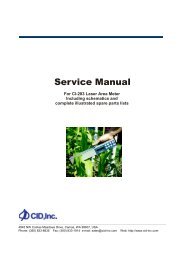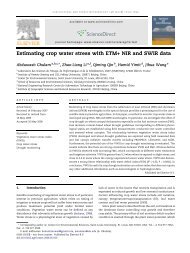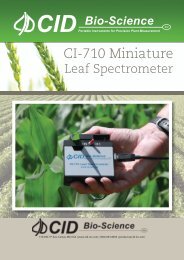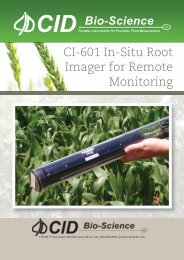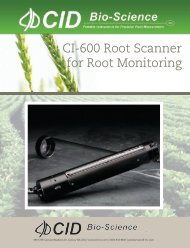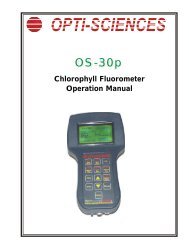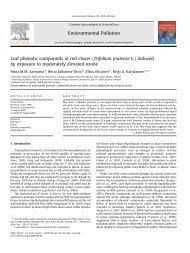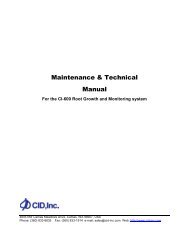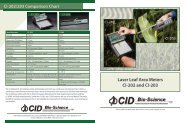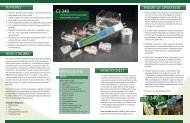Nanoporous Gold Electrocatalysis for Ethylene Monitoring ... - CID, Inc.
Nanoporous Gold Electrocatalysis for Ethylene Monitoring ... - CID, Inc.
Nanoporous Gold Electrocatalysis for Ethylene Monitoring ... - CID, Inc.
You also want an ePaper? Increase the reach of your titles
YUMPU automatically turns print PDFs into web optimized ePapers that Google loves.
172 Shekarriz and L. Allen: <strong>Nanoporous</strong> <strong>Gold</strong> <strong>Electrocatalysis</strong> <strong>for</strong> <strong>Ethylene</strong> <strong>Monitoring</strong><br />
While long term storage of fruit and vegetables results<br />
in eventual ripening due to production and release of ethylene,<br />
monitoring of ethylene is currently not a widely<br />
adopted process in many packing houses and cold storage<br />
facilities. This is attributable to limited sensitivity and accuracy<br />
of current sensors. At or below 1 ppm detectors<br />
with sufficient sensitivity are too large and too expensive<br />
<strong>for</strong> most end-users to af<strong>for</strong>d. Localization of more rapidly<br />
ripening fruit and sources of ethylene is challenged by the<br />
high cost and inconvenience in detection. Such localization<br />
could provide strategies to minimize ethylene production<br />
and to control spoilage and rapid ripening process.<br />
Another application of the ETH-1010 ethylene sensor<br />
is <strong>for</strong> the determination of fruit maturity at harvest. This<br />
application plays a major role in determining storability,<br />
marketability, transportability, and general quality of<br />
climacteric fruit (SHEKARRIZ 2007; BLANKE 2008). A<br />
number of parameters are currently used to evaluate the<br />
maturity index of fruits and vegetables at harvest<br />
(http://www.hortresearch.co.nz/index/page/442). Examples<br />
of indices currently used <strong>for</strong> determining the commercial<br />
maturity are background skin colour, starch pattern<br />
index, and firmness. While physiological maturity determined<br />
from internal ethylene concentration (IEC) does<br />
not seem to correlate well with commercial maturity indices,<br />
it is a good indicator of storability and transportability<br />
of fruit (http://www.hortnet.co.nz/publications/science/m/mills/apple.htm).<br />
There<strong>for</strong>e, harvest and postharvest<br />
storage and distribution decisions are more frequently<br />
based on internal ethylene concentration measurements,<br />
in addition to using the traditional indicators.<br />
Currently internal ethylene levels are measured by expert<br />
users taking a gas sample from an apple (intrusively using<br />
a core sampler or non-intrusively by collecting the ethylene<br />
outgas of the fruit) and running the sample through a<br />
laboratory gas chromatography (GC) system. This process<br />
is time consuming and expensive, limiting the number of<br />
growers and users that could benefit from this in<strong>for</strong>mation.<br />
The US Department of Agriculture (USDA) and university<br />
agricultural extension centres play a major role in<br />
introducing and implementing more efficient and<br />
up-to-date practices into the current quality control (QC)<br />
culture within the postharvest industry in the US. The following<br />
sections provide more details on the method and<br />
device <strong>for</strong> rapid and cost-effective ethylene concentration<br />
measurement during postharvest applications.<br />
catalytic metals such as platinum, palladium, nickel, cobalt,<br />
etc. have been shown to have interesting catalytic<br />
properties as nanoparticles, but these metals are already<br />
recognized heterogeneous catalysts (THOMPSON 1999).<br />
<strong>Gold</strong> in a nanoparticulate state, however, provides a new<br />
area of catalysis research, sometimes known as the “New<br />
<strong>Gold</strong> Rush.”<br />
Typically, a heterogeneous catalyst consists of a small<br />
amount of metal deposited on the surface of a metal oxide.<br />
Metal oxides such as alumina, ceria, zirconia, ferric oxide,<br />
titanium dioxide, and mixtures of metal oxides provide a<br />
support <strong>for</strong> the catalytic metal. They also provide a<br />
source/sink <strong>for</strong> oxygen in oxidation reactions. To be a catalyst,<br />
the dispersed metal must first adsorb both reactants<br />
and not significantly attract the products. This mechanism<br />
provides the pathway <strong>for</strong> bringing reactant molecules together<br />
to facilitate the reaction. Interestingly, nanoporous<br />
gold plated on a number of metal oxide substrates has attracted<br />
much attention <strong>for</strong> the catalytic oxidation of many<br />
small molecule and carbon-containing compounds. This is<br />
an important property <strong>for</strong> our consideration in that ethylene<br />
and other small molecules are attracted and adsorbed<br />
to the nanoparticle gold (GOTTFRIED 2003). This makes<br />
them ideal targets <strong>for</strong> electrochemical oxidation using our<br />
nanoparticle gold electrode cell. The successful oxidation<br />
of ethylene, propylene, ethylene glycol, <strong>for</strong>maldehyde,<br />
acetaldehyde, <strong>for</strong>mic acid and carbon monoxide with air<br />
or oxygen has been reported (BURKE and NUGENT 1998).<br />
Electrocatalytic Cell and Its Operation<br />
The oxidation of ethylene contained in the sampled air<br />
flowing over a nanoporous gold anode, also known as a<br />
Working Electrode, provides a cell current that can be<br />
measured and used <strong>for</strong> the determination of ethylene<br />
concentrations in this sample (Fig. 1). In the present electrocatalytic<br />
cell, the gold working electrode provides<br />
electrical contact through a water and proton permeable<br />
Nafion® membrane, to the liquid chamber containing<br />
electrolyte, and counter- and reference- electrodes. Water<br />
that penetrates the Nafion membrane and wicks onto the<br />
gold surface is activated by the cell potential where it becomes<br />
the oxidizing agent <strong>for</strong> ethylene.<br />
For sensing, the cell potential is maintained at 1.16 V<br />
vs. standard hydrogen electrode (SHE). Under this condi-<br />
Materials and Methods<br />
The Electrocatalyst<br />
C2H4 + Air Flow<br />
Sensing Electrode (Anode):<br />
<strong>Nanoporous</strong> <strong>Gold</strong><br />
Solid Polymer Electrolyte: Nafion<br />
At the heart of this device is a nanoporous gold electrocatalytic<br />
surface that is the primary sensing element. The<br />
basis <strong>for</strong> sensing by electrocatalytic oxidation of various<br />
analytes on gold is presented in other publications<br />
(SCHMIDT and PASTOR 1994; BURKE and NUGENT 1998). In<br />
this approach, the nano-particulate gold surface is active<br />
in adsorbing the analyte, e.g., ethylene molecules. Although<br />
gold is considered to be a noble and extremely<br />
unreactive metal, numerous reports in recent years show<br />
that atomic gold clusters ranging in size from 2 to 20 nm<br />
are highly active as heterogeneous catalysts in a number<br />
of chemical reactions (SANCHEZ et al. 1999; CORTIE and<br />
VAN DER LINGEN 2002; ASTRUC et al. 2005). Other typical<br />
Counter<br />
Electrode<br />
(Cathode)<br />
Electrolyte Solution:<br />
Reference<br />
0.05 M H 2 SO 4<br />
Electrode<br />
Potentiostat<br />
Fig. 1. Electrocatalytic reaction of ethylene on nanoporous<br />
gold catalyst.<br />
Europ.J.Hort.Sci. 4/2008





